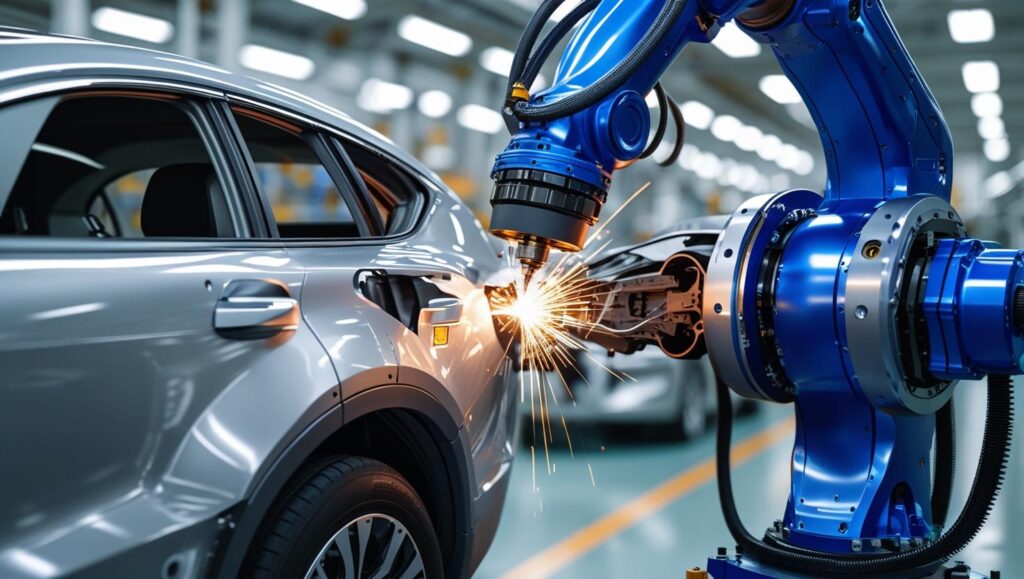The global automotive manufacturing equipment market continues to experience robust growth, driven by technological innovation, the rise of electric vehicles (EVs), and increasing automation in vehicle production. As automakers scale production to meet global demand and transition toward next-generation mobility solutions, manufacturing equipment has become the backbone of operational efficiency and quality assurance.
Revenue within this market is largely segmented by application areas—each playing a critical role in the automotive value chain. From body assembly and welding to final vehicle testing, each application contributes uniquely to the market’s growth trajectory.
1. Body Assembly and Welding: Leading Revenue Generator
Body assembly and welding equipment account for the largest share of market revenue. Automated welding robots, framing systems, and laser welding tools are integral to constructing vehicle bodies with high precision and durability. This application remains a top revenue contributor, especially in regions with high adoption of robotics and automation, such as Germany, Japan, South Korea, and the United States.
OEMs are increasingly integrating advanced welding technologies—including remote laser welding and adaptive control systems—to enhance speed, consistency, and material compatibility, especially for lightweight structures and mixed-metal designs in electric vehicles.
2. Machining and Fabrication: Precision Drives Profitability
Machining and fabrication equipment—such as CNC machines, drilling tools, and milling systems—represent a significant portion of the market’s revenue. These systems are used in the production of engine components, chassis parts, and structural elements, requiring a high level of accuracy and repeatability.
As combustion engines are gradually phased out in favor of electric powertrains, this segment is adapting by shifting toward e-mobility applications, including the production of battery casings, electric drive components, and gear assemblies for electric drivetrains.
3. Painting and Coating: Consistent Surface Finishing, High ROI
Painting and surface coating systems, including spray booths, drying ovens, and robotic applicators, contribute substantially to market revenue. These systems not only enhance the aesthetic appeal of vehicles but also protect against corrosion and wear.
Driven by rising environmental regulations, there’s a growing trend toward eco-friendly and water-based coating systems, which are boosting equipment replacement demand and expanding market opportunities. Automated paint shops with closed-loop control systems are becoming the norm for reducing waste and improving finish quality.
Download PDF Brochure @ https://www.marketsandmarkets.com/pdfdownloadNew.asp?id=75023639

4. Powertrain Assembly: Revenue Shifts Toward Electrification
Powertrain assembly has traditionally been a key revenue driver, particularly in internal combustion engine (ICE) vehicle production. However, the segment is now witnessing a significant shift as manufacturers reallocate investment toward electric powertrain assembly—including battery pack integration, electric motor assembly, and power electronics installation.
This transformation is reshaping revenue distribution within the segment, as demand for traditional ICE equipment slows while EV-related assembly equipment accelerates in both revenue and innovation.
5. Final Assembly and Inspection: Driving Quality and Compliance
Final assembly lines encompass a wide range of equipment, including torque systems, sealant dispensers, fastening tools, and automated guided vehicles (AGVs). These systems ensure the precise integration of all vehicle subsystems and are critical to maintaining safety and performance standards.
In parallel, vehicle testing and inspection equipment—such as wheel alignment systems, emission testers, and advanced diagnostic machines—contribute steadily to market revenue. With the integration of more electronics and software into vehicles, especially in EVs and autonomous platforms, inspection systems are evolving to support real-time analytics and predictive maintenance during assembly.
6. Material Handling Systems: Enabling Smart Factories
Material handling applications—such as conveyors, robotics, and AGVs—are becoming increasingly important as factories transition to Industry 4.0 environments. These systems ensure efficient movement of parts and components across complex assembly lines and are essential for reducing downtime and improving throughput.
Automated material handling solutions are projected to grow in both usage and revenue contribution, particularly in greenfield EV manufacturing plants and smart factories adopting lean production strategies.
Revenue Outlook: Strong Growth Driven by Electrification and Automation
The future of automotive manufacturing equipment market revenue by application is being shaped by several converging forces:
The global automotive manufacturing equipment industry is expected to be valued at USD 31.99 billion in 2025 and reach USD 41.70 billion by 2030, growing at a CAGR of 5.4% from 2025 to 2030
Electrification: As EV production scales globally, investments in battery assembly, electric motor manufacturing, and lightweight structure processing are driving new application-specific revenues.
Automation: Smart assembly systems, robotics, and AI-enabled quality control are becoming essential across every application area.
Customization and Flexibility: Equipment that supports modular assembly lines and multi-model production is gaining favor among OEMs and Tier 1 suppliers.
According to recent industry analyses, application segments aligned with EV manufacturing, lightweight body structures, and intelligent final assembly will experience the fastest revenue growth through 2030.
The automotive manufacturing equipment market is increasingly application-driven, with each segment contributing to operational efficiency, vehicle quality, and technological advancement. As automakers continue to invest in next-generation vehicles and smart factory infrastructure, the demand across all application areas—from welding to testing—is expected to grow steadily.
Staying ahead of these trends requires an agile approach to technology adoption, a commitment to sustainability, and strategic investment in automation and electrification-ready systems.
FAQ –
1. What application segments are generating the most revenue in the automotive manufacturing equipment market?
The highest revenue-generating segments include body assembly and welding, followed by machining and fabrication, painting and coating, and powertrain assembly. As automotive OEMs scale up production, these core application areas remain fundamental to manufacturing operations and offer stable investment opportunities.
2. How is the transition to electric vehicles (EVs) impacting market revenue by application?
The shift toward EV production is significantly reshaping application-specific revenues. Powertrain assembly is transitioning from traditional internal combustion systems to EV components, including battery pack assembly and electric drive systems, opening up new revenue streams in related equipment and automation tools.
3. Which application areas are expected to see the highest growth over the next 5 years?
Application areas related to EV manufacturing, particularly battery integration, lightweight body assembly, and automated final assembly systems, are projected to grow the fastest. Material handling and testing & inspection systems are also gaining momentum as smart factory adoption increases.